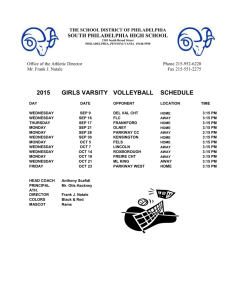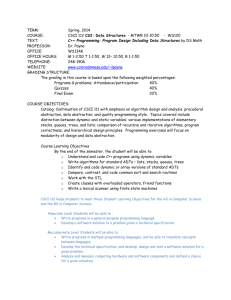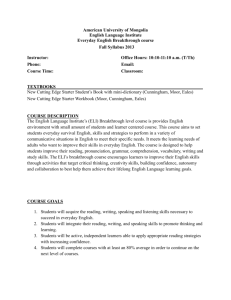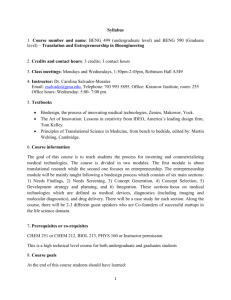UNIVERSIDAD DE ESPECIALIDADES ESPÍRITU SANTO
advertisement
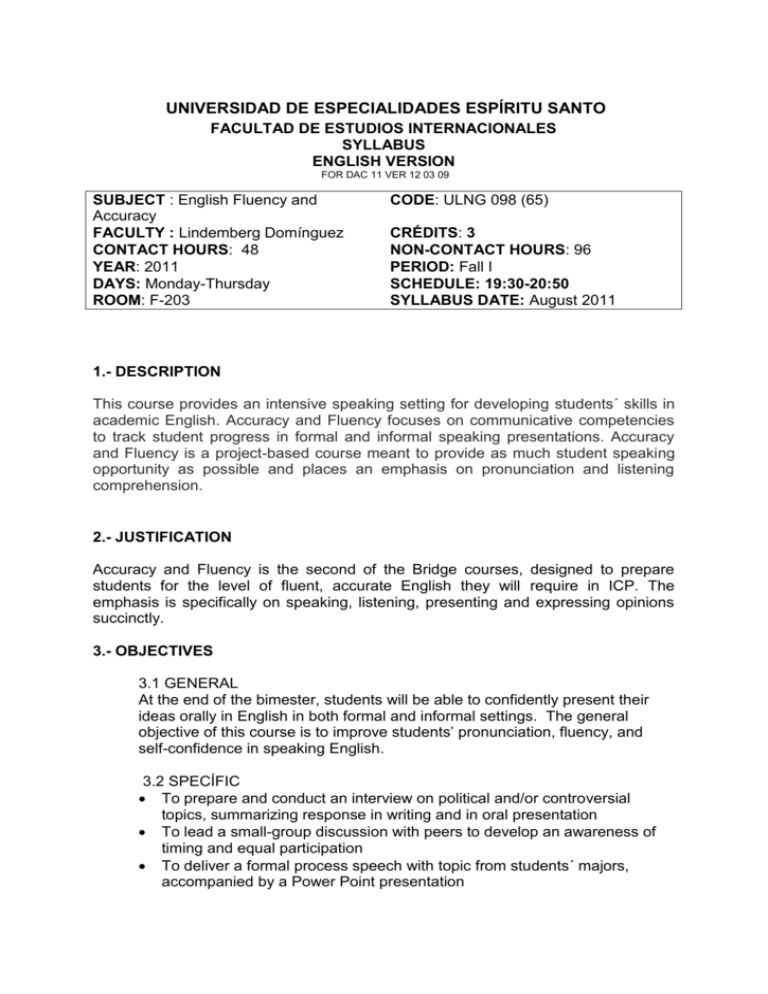
UNIVERSIDAD DE ESPECIALIDADES ESPÍRITU SANTO FACULTAD DE ESTUDIOS INTERNACIONALES SYLLABUS ENGLISH VERSION FOR DAC 11 VER 12 03 09 SUBJECT : English Fluency and Accuracy FACULTY : Lindemberg Domínguez CONTACT HOURS: 48 YEAR: 2011 DAYS: Monday-Thursday ROOM: F-203 CODE: ULNG 098 (65) CRÉDITS: 3 NON-CONTACT HOURS: 96 PERIOD: Fall I SCHEDULE: 19:30-20:50 SYLLABUS DATE: August 2011 1.- DESCRIPTION This course provides an intensive speaking setting for developing students´ skills in academic English. Accuracy and Fluency focuses on communicative competencies to track student progress in formal and informal speaking presentations. Accuracy and Fluency is a project-based course meant to provide as much student speaking opportunity as possible and places an emphasis on pronunciation and listening comprehension. 2.- JUSTIFICATION Accuracy and Fluency is the second of the Bridge courses, designed to prepare students for the level of fluent, accurate English they will require in ICP. The emphasis is specifically on speaking, listening, presenting and expressing opinions succinctly. 3.- OBJECTIVES 3.1 GENERAL At the end of the bimester, students will be able to confidently present their ideas orally in English in both formal and informal settings. The general objective of this course is to improve students’ pronunciation, fluency, and self-confidence in speaking English. 3.2 SPECÍFIC To prepare and conduct an interview on political and/or controversial topics, summarizing response in writing and in oral presentation To lead a small-group discussion with peers to develop an awareness of timing and equal participation To deliver a formal process speech with topic from students´ majors, accompanied by a Power Point presentation To participate in a timed debate to enhance extemporaneous thinking and production To deliver an oral and written character analysis based on assigned reading To give a chronological account of the adventures of a character from an assigned reading as part of a group presentation To increase awareness of pronunciation difficulties and solutions 4.- COMPETENCIES To express opinions spontaneously with good grammatical control and good pronunciation To recognize common errors and employ self-correction To demonstrate fluent spoken English To deliver a formal speech in front of an audience To analyze literary characters To justify opinions in a pressurized environment 5.- COURSE CONTENT OUTLINE DATE Specific competencies Aug. 29 Introduces syllabus and course materials, student interviews and introductions / Types of Sentences Aug. 30 Content -Syllabus and course materials, introductions -Develop question list for interview -Student Introductions/reported speech based on interviews Aug. 31 - Discuss Reading 1 & 2 - Introduction to Activity Management (roles and tasks in leading smallgroup discussion and practice) -Introduce topics for next week Sep. 1 - TV show pitch activity Homework/ ASSESSMENT projects/ (performance assignments indicators) (Non-Contact Hours) - Prepare student Participates in introduction 2 hour class discussion - Reading 1 (Formal English) - Reading 2 (Teaching) Demonstrates speaking extemporaneously Participates in class discussions Analyzes reading Demonstrate extemporaneous speaking - Copy reading packet Demonstrates speaking extemporaneously Sep. 5 Sep. 6 Sep. 7 Sep. 8 Sep. 12 Sep. 13 Sep. 14 Sep. 15 Expresses spontaneously with good grammatical control without much sign of having to restrict what he/she wants to say, adopting a level of formality appropriate to the circumstances. Students lead class activities - Prepare activity Manages group activities Students lead class activities - Prepare activity Manages group activities Students lead class activities - Make a list of 10 minor problems in your life - Reading 3 (Editorial: problem/complaint) - Plan problem solution presentation Manages group activities Identifies the roles of the Parts of Speech in order to create complex and varied sentence structures. Problem Solutions Exam Finalize prep presentation Demonstrates planned speaking Problem Solution Presentation Finalize presentation Demonstrates planned speaking - Reading 4 Demonstrates planned speaking - Research pronunciation difficulties English/Spanish - Bring in list of 10 hard to pronounce words Analyzes reading Demonstrate extemporaneous speaking -Problem Solutions Exercise Problem Solution Recognizes Presentation errors and able to do selfcorrection -Discuss presentations - Reading 4 Discussion Demonstrates speaking extemporaneously Date Sep. 19 Specific competencies Content Delivering speeches Language of speeches workshop Sep 20 Practice run for process speeches Mid-term Sep. 21 Assessment (performance indicators) Preparation for process speech Demonstrates planned speaking Preparation for process speech Demonstrates planned speaking Assessment of speeches Demonstrates planned speaking Process speech Mid-term Sep. 22 Homework/Assignments Non-contact hours Process speech Date Sep. 26 Sep. 27 Sep. 28 Sep. 29 Specific competencies Content Recognises Pronunciation differences of practice ed endings both form and meaning of grammar structures. Distinguishes between tenses to understand Pronunciation when an action practice takes place. Recognises differences of _s endings in English. Recognizes differences of th sounds Pronunciation practice Homework/Assignments Assessment Non-contact hours (performance indicators) Pronunciation drills Reading “26 most common errors of Spanish Speakers in English” Prepares reading with particular note to pronunciation. Discussion and practice drills Discussion and practice drills Pronunciation practice Discussion and practice drills Date Oct. 3 Oct. 4 Specific competencies Content Homework/Assignments Non-contact hours Assessment (performance indicators) Critical reading and discussion A selection of readings on topics selected by teacher Preparation of reading and discussion points Quizzes Reading Discusses topic Reading Demonstrates planned speaking Reading Demonstrates speaking extemporaneously Spontaneous discussion Selected readings Oct. 5 Oct. 6 Prepared arguments in favor and against Selected readings and topic Written and oral expression Selected reading and topic Date Oct. 10 Oct. 11 Oct. 12 Specific competencies Content Homework/Assignments Non-contact hours Assessment (performance indicators) Recognises debate language and distinguishes ways of agreeing and disagreeing Introduction to debates Debate topic development in class Reading on debate topic chosen for next day´s class eg TIME Mexican President wants to legalise all drugs Participates in class discussion Mock debate Research the Benny Expresses point Assign Agrelo euthanasia case of view and debate teams or other topic as chosen defends by teacher argument Watch, Listening and discuss and comprehension, critique expressing famous opinions debates Preparation for debate Preparation for debate Oct. 13 Listen and complete worksheet Watch you tube marijuana debate Analyses reading and discusses case Date Oct. 17 Specific competencies Content Homework/Assignments Non-contact hours Assessment (performance indicators) Final exam Debates Demonstrates planned speaking Final exam Debates Demonstrates planned speaking Oct. 18 6.- METHODOLOGY Based on the Communicative Approach, or notional-functional approach, this course ¨aims to make communicative competence the goal of language teaching and develop procedures for the teaching of the four language skills that acknowledge the interdependence of language and communication.¨ While this approach has various interpretations, peer work, group problem solving, and focus on different types of communicative purpose are at its core, and are exemplified in the projects required in this course. Breen and Candlin describe the role of the learner: ¨The role of the learner as negotiator – between the self, the learning process, and the object of learning – emerges from and interacts with the role of joint negotiator within the group and within the classroom procedures and activities which the group undertakes. The implication for the learner is that he should contribute as much as he gains, and thereby learn in an interdependent way.¨ They go on to describe the role of the teacher in Communicative Language Teaching: ¨The teacher has two main roles: the first role is to facilitate the communication process between all participants in the classroom, and between these participants and the various activities and texts. The second role is to act as an independent participant within the learning-teaching group. The latter role is closely related to the objectives of the role and arises from it. These roles imply a set of secondary roles for the teacher; first, as an organizer of resources and as a resource himself, second as a guide within the classroom procedures and activities… A third role fro the teacher is that of researcher and learner, with much to contribute in terms of appropriate knowledge and abilities, actual and observed experience of the nature of learning and organizational capacities.¨ (Breen, M. and C. N. Candlin. 1980. The essentials of a communicative curriculum in language teaching. Applied Linguistics 1 (2): 89-112. Additional roles for teachers are needs analyst, counselor and group process manager. 7.- EVALUATION 7.1 Assessment Criteria Homework Written quizzes Class participation Presentations Written and Oral exams 7.2 Performance Markers Gives various examples of planned and extemporaneous speaking Analyzes readings Manages group activities in the classroom setting 7.3 Weighting Partial 1: Classwork Quizzes Participation Oral Exam 25 % 10 % 15 % 50 % Partial 2: Classwork Quizzes Participation Oral Exam 25 % 10 % 15 % 50 % 8.- BIBLIOGRAPHY 8.1 Required Reading packet provided by professor 8.2 Complementary To be provided my professor 8.3 Hand-outs 8.4 WEBliography 9.- FACULTY INFORMATION NAME: Dr. Líndemberg Domínguez, M Ed. ACADEMIC CREDENTIALS: Masters in Bilingual Education : Teaching English as a Second Language and Administrating Bilingual Programs Medical Doctor E-MAIL ADDRESS: lindembergdm@ hotmail.com 10.- FACULTY SIGNATURE AND OR DEAN/DIRECTOR’S APPROVAL (SIGNATURE) Prepared by: Lindemberg Domínguez Reviewed by: Dean Monica Reynoso Date: August 2011 Date: August 2011
